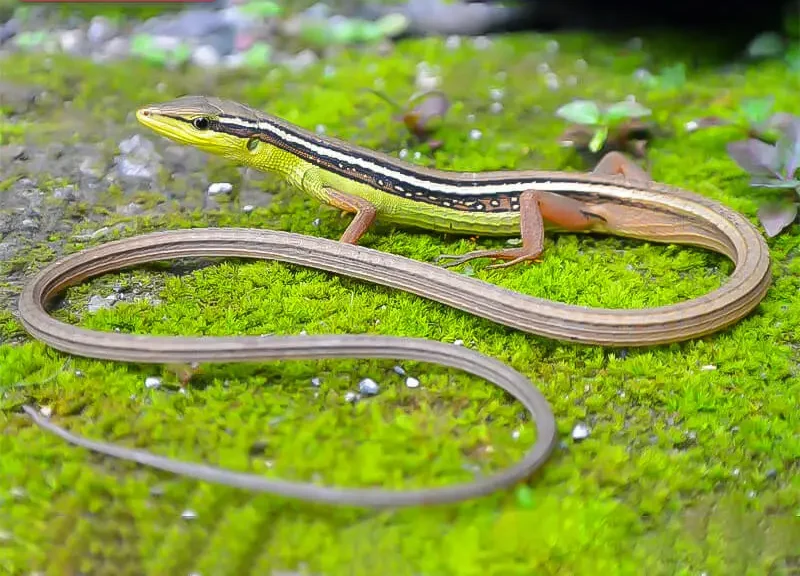
Description:
Scientific name: Takydromus sexlineatus
Life span: 5-6 years
The long-tailed grass lizard, also known as the Asian grass lizard, is an arboreal species of lizard that is active during the day. It has six stripes on its tail. The distinctive feature of the long-tailed grass lizard is its long tail. It also has a white to cream colored underbelly and a brown, green, or beige back that is frequently covered in stripes that are varying colors of brown. It normally has a small head, a snout that is acutely pointed, and a tongue that is pink or black. Small, pointed scales behind the chin that resemble a beard are present on its thin, slightly elongated body. Females lack the white markings that males have on their flanks.
Native Region/Habitat
The native of several nations, including China, India, Thailand, and Indonesia, Takydromus sexlineatus is widespread in South East Asia. The ocellatus subspecies is present in places like southern China, northern Burma, and northern Malaysia.

Behavior:
These lizards are only active during the day and come out in the morning to enjoy the sunshine. If a possible predator approaches, they will initially remain motionless. If the threat continues, they will then run for cover in the surrounding vegetation. Both sexes appear to communicate with one another by waving their arms in a motion resembling the front crawl of a swimmer. They are swift and incredibly agile.
Care As a pet/In captivity:
Housing:
The minimum tank size needed to house a single long-tailed lizard is a 20-gallon vertical, hexagonal tank; each additional lizard will require an extra ten gallons of enclosure area (i.e. a 30-gallon tank for three lizards). It is recommended to use a screened top, but it must be quite secure; only a lid that is firmly secured will prevent these nimble lizards from fleeing.
Heat:
Give your long-tailed grass lizard a basking area between 90 and 95 degrees Fahrenheit; the main enclosure should have an ambient temperature between 75 and 85 degrees Fahrenheit. This will create the necessary thermal gradient during the day. If the temperature drops too much below 65 to 75 degrees Fahrenheit at night, your lizard may become ill from not being able to properly digest its food.
Humidity:
Always keep the tank’s humidity between 70 and 75 percent; get a hygrometer to ensure that your humidity level is accurate. While many long-tailed grass lizards can only drink from water droplets on the leaves in the tank, a shallow water dish will aid with humidity while also misting the tank every day.
Food and Water:
Long-tailed grass lizards can be fed primarily on live crickets. To provide diversity, add mealworms, waxworms, butter worms, and flies. Before feeding, make sure the prey has been gut-loaded by your lizard. When compared to youngsters, adult long-tailed grass lizards can be fed numerous crickets every other or third day. Dust the prey items with a vitamin and mineral supplement once every week (including calcium and Vitamin D3).
Clean, fresh, non-chlorinated water should also be available in a shallow water dish. Try utilizing a reptile drip system to train arboreal lizards to drink from a dish (similar to the one used for chameleons).
Table





